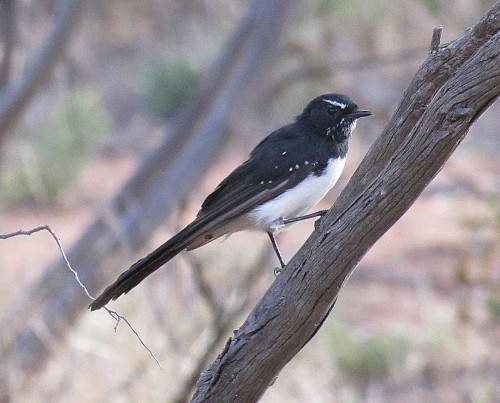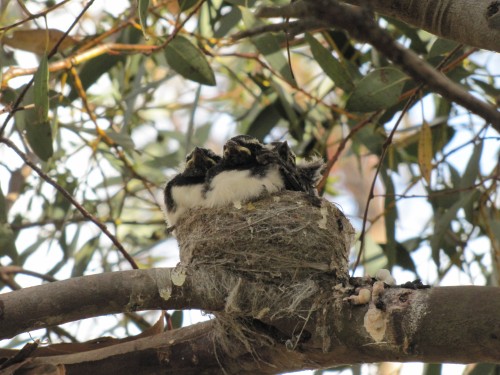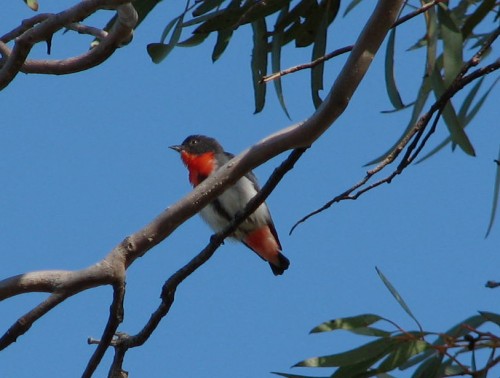A feisty Willie Wagtail
One of the most recognisable Australian birds would be the Willie Wagtail (see photo above). It is also one our most endearing birds, a favourite of many people. It loves occupying spaces close to human habitation, especially our gardens. We have a resident pair in our garden and we see them on a daily basis.
I have always known that Willie Wagtails can also be aggressive, feisty little birds. This has been in evidence in recent days in our garden, illustrated by the following incidents when it has attacked other, much larger species:
- Australian Magpies: our resident Magpies must be nesting somewhere on our five acre property here in South Australia. The male is consistently chasing almost every bird which comes near. Fortunately us humans are never swooped. Last Saturday, however, the roles were reversed. It was the magpie being chased – by a very aggressive and angry Willie Wagtail snapping at its tail as it tried to escape its wrath.
- Little Ravens: We often have small flocks of Little Ravens in our garden, usually up to about six or so. Yesterday I heard and then saw three ravens in the large mallee trees at the back of our home. As usual, they were cawing loudly. This attracted the attention of the Willie wagtail who rapidly came into the situation and began snapping at a raven’s feathers, tail and head, harassing the poor bird mercilessly. As soon as one raven flew off with a few caws in protest, the Willie Wagtail would turn its attention to another until all three were well and truly seen off the property.
Wedge-tailed Eagles
I have only observed Australia’s largest bird of prey, the Wedge-tailed Eagle, on one occasion here in over 30 years. It is, however, quite a common bird throughout this part of the country and I have seen the species on many occasions in my travels. It always amazes when the tiny Willie Wagtail – not much bigger than a humble House Sparrow – aggressively attacking the eagle, snapping at it and even pecking at its back while hitching a ride. Such courage – one snap of the eagle’s beak would dismiss the wagtail permanently.
The reason for this aggressive attitude:
Normally the Willie Wagtails are friendly, docile birds. They will allow all manner of birds to cohabit happily in our garden. The reason for this sudden change of attitude is a simple little nest, like the one shown below. The photo below was taken a few years ago because I don’t want to disturb the mother Willie wagtail. She is currently sitting on two lovely eggs. She is not even afraid to come after me when I get near to the nest, snapping near my head until I move a reasonable distance from the nest.
The weeds near the nest will just have to wait a few weeks to be mown. Sigh.
I recently wrote about other birds nesting in our garden (click here).
A Mistletoebird pays a quick visit
Yesterday my wife and I were taking a short break from the jobs we had been doing. Sitting on our back veranda we were enjoying the lovely sunny spring weather we have had this week. It was afternoon tea time and we were enjoying a well deserved cup of tea. The back veranda has been a bit of a mess over the winter months and the weather has been too cold to spend too much time cleaning it up. Now that the spring weather is here we had a renewed enthusiasm for being outside.
While we sat there we enjoyed the constant parade of birds hopping around in the garden nearby. Many others were calling and we enjoy trying to identify them by call alone, a good way of honing one’s identification skills. Our resident Superb Fairy-wrens entertain us every day, as do the Mallee Ringneck parrots, the Eastern Rosellas and the Galahs. We can’t work out if the Galahs are actually nesting or not. The Spotted Turtledoves often join in the chorus and in recent days we have had the delight of Peaceful Doves also hanging around near the house.
As we sat there we were delighted to have a female Mistletoebird fly in and alight on a bush in full view just three metres from us. We were able to see the soft, dull grey colours of the feathers on her back, a stark contrast with the blue-black feathers of the male (see photo above). I didn’t have the camera handy, and the bird flew off after less than a minute, so I have shared a photo of the male taken some years ago. I do have one photo of the female, but unfortunately it is not in focus. Sigh.
I cannot categorically say that this is a resident species in our garden and on our 5 acre property, but it is certainly a regular visitor. I hear its call almost every week. Many years ago this was the first species to nest in one of the trees we planted after moving here. There may have been other species before it, but this was the first one we positively recorded doing this. The nest is a delicate pear-shaped container with a small entrance near the top. It is made primarily from spiders’ webs, small leaves, lichen and other soft materials, and hangs from small twigs or leaves. They are just coming into their breeding season, so I need to keep an eye open for a nest. This species is found throughout mainland Australia except in the driest regions. It is not present in Tasmania.
Further reading:
- Beautiful Mistletoebird
- Great Birding Moments #3
- If you click on the name of any of the bird species mentioned in the text above, you can go to other articles about that species.


